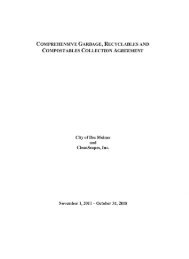CITY OF DES MOINES SHORELINE MASTER PROGRAM
CITY OF DES MOINES SHORELINE MASTER PROGRAM
CITY OF DES MOINES SHORELINE MASTER PROGRAM
Create successful ePaper yourself
Turn your PDF publications into a flip-book with our unique Google optimized e-Paper software.
Des Moines Shoreline Inventory and Characterization<br />
Climate<br />
The Puget Lowland has a maritime climate with cool winters, dry summers, and a distinct rainy<br />
season. Precipitation in the Lowland varies considerably because of mountain effects. The Des<br />
Moines area watershed receives between 35 and 40 inches of rain per year on average, with 75<br />
percent of the precipitation falling from October to March (Woodward et al., 1995). Winds are<br />
generally from the southwest during the rainy season and from the northwest during the dry<br />
summer months.<br />
Topography<br />
The Des Moines area watershed is located on the western portion of the Des Moines Plain, a<br />
broad northerly-trending upland area located between the Duwamish-Green River valley and<br />
Puget Sound. The upland plateau area has relatively low relief and largely lies 300 to 400 feet<br />
above sea level. The upland area is bounded to the east and west by steep bluffs (Figure 4).<br />
The watershed comprises the western two thirds of the Des Moines Plain. The upland ground<br />
surface has local closed depressions occupied by lakes and poorly drained areas occupied by<br />
wetlands and peat bogs. Streams draining the watershed are relatively short and flow directly to<br />
Puget Sound.<br />
Vegetation<br />
As the watershed is largely covered with medium to high density, residential and commercial<br />
development, much of the natural land cover has been altered (Figures 6a and 6b). Large areas<br />
of native vegetation within the watershed are generally restricted to steep slopes along streams.<br />
Stream valleys that have not been significantly developed have been incorporated into parks or<br />
other government property. Other areas of native vegetation include larger institutional<br />
properties. Native vegetation in undeveloped areas include trees, such as Douglas fir, Western<br />
red cedar, Western hemlock, Pacific madrone, big leaf maple, and alder. Such trees remain in<br />
residential areas but have been thinned considerably to accommodate housing. Common<br />
understory plants in undeveloped areas include salal, ferns, Indian plum, Oregon grape,<br />
elderberry, oceanspray, and salmonberry.<br />
Geology and Soils<br />
The geology of the Des Moines vicinity is well documented by Waldron (1961 and 1962). More<br />
recent geologic mapping of the area has been conducted by the University of Washington’s<br />
Pacific Northwest Center for Geologic Mapping Studies (Booth and Waldron, and Booth et al.,<br />
in press). The geology along the shoreline is also documented in the Coastal Zone Atlas of King<br />
County (Washington State Department of Ecology [Ecology], 1979). Soils are shown on Figure<br />
3, surficial geologic units on Figure 4.<br />
The Des Moines Plain is underlain by a complex sequence of glacial and nonglacial deposits that<br />
overlie Tertiary bedrock. The depth to bedrock in the vicinity of the project area is<br />
approximately 1,000 to 1,500 feet (Jones, 1996). The area has been glaciated six or more times<br />
in the past 2 million years. Each glacial advance may have deposited a sequence of fine-grained<br />
lacustrine deposits, outwash sand and gravel, and till. Each of these deposits may have been<br />
March 2005 Page 9



